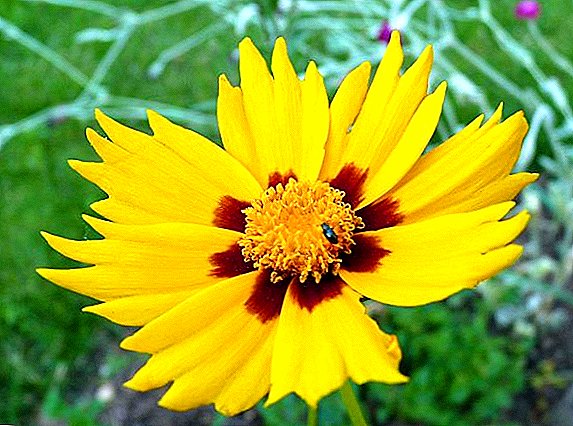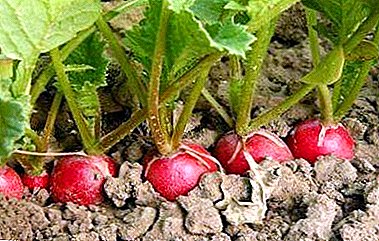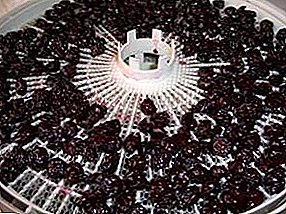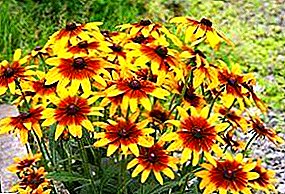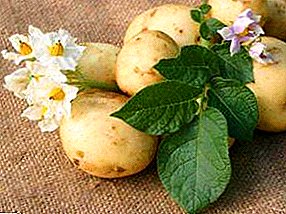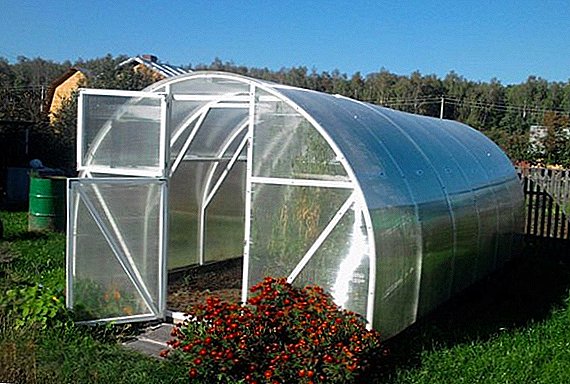 Many are accustomed to purchased seedlings of roses with open roots and long stems. And recently appeared on sale cardboard tubes in which shortened copies are packed, the flower growers are alarming. There is an opinion that these seedlings have little chance of rooting because of the very pruned roots and sprouts. In fact, the flower dies due to improper unpacking and planting. How to plant roses bought in a box, which should take into account what kind of care is needed for the culture - we will describe all this later in the article.
Many are accustomed to purchased seedlings of roses with open roots and long stems. And recently appeared on sale cardboard tubes in which shortened copies are packed, the flower growers are alarming. There is an opinion that these seedlings have little chance of rooting because of the very pruned roots and sprouts. In fact, the flower dies due to improper unpacking and planting. How to plant roses bought in a box, which should take into account what kind of care is needed for the culture - we will describe all this later in the article.
Criterias of choice
The usual careful examination of the stems and root system, which is the key to a successful purchase of any seedling, in this case does not work. In the box you will find a rose with strongly shortened shoots and roots, which are wrapped in black polyethylene.
To see the state of the roots in the store or garden center is almost impossible. After all, unpacking planting material is not allowed. Yes, and incorrect extraction of the seedling from the tube can only harm him.
Important! So that buying a rose in a box does not turn into your disappointment, choose seedlings with several strong rots, on which there is a healthy and solid bark of green color, and also there are several budded buds. It is very good if the stalks of a rose are coated with wax or paraffin.
 Carefully read the information on the packaging. Experienced growers are advised to give preference to grafted samples, because they easily adapt to the soil and climatic conditions of the temperate zone, develop better and bloom profusely.
Carefully read the information on the packaging. Experienced growers are advised to give preference to grafted samples, because they easily adapt to the soil and climatic conditions of the temperate zone, develop better and bloom profusely.Also well proven seedlings of the southern varieties of domestic or Dutch production.
Remember that bright alluring photos with roses of unreal beauty on the package often do not justify themselves precisely because of the stunted and not viable content of the tuba.
Therefore, do not hesitate to examine the available part of the product. Pay special attention to the root neck of the seedling. It should be uniform and not exceed 8 mm in volume.
Some buyers mistakenly believe that seedlings with tall shoots will bloom immediately after rooting. In fact, such instances, as a rule, do not survive.
This happens because they are weakened, and as a result of a long stay in warm conditions without the necessary lighting they have increased many thin but not viable shoots. 
Did you know? The Egyptian queen Cleopatra also went down in history as a zealous fan of roses. No solemn event with her participation could not do without these beautiful flowers. Their petals, on the orders of the Queen, densely carpeted the floors of the halls for balls. In special cases, these floorings reached half a meter in height. Rose petals swaying on the waves always accompanied Cleopatra on her walk to the gallery.
How to save before landing
Experts consider the period from the second decade of April to the first day of May to be the optimal time for rooting acquired seedlings. At this time, the earth warmed up sufficiently, and stable heat recovered outside.
Often the roses in the box appear on sale at the end of February, so we’ll understand in detail how to save them before planting.
The first option is to artificially suspend the development of a seedling. To this end, it is placed for a month in the refrigerator, on the balcony or in an unheated veranda. Closer to the time of planting, it is desirable to give the plant a few days to move away from forced hibernation.
Another way for caring owners who are not too lazy to prikopat seedling or plant it in a small indoor pot. Before this, it is advisable to inspect the roots, remove all damaged parts and treat them with growth stimulants. Experts advise shortening long roots. Potted roses from the tube after planting need to cover the package and put on the balcony or veranda. Heat during this period is contraindicated because the flower will develop greatly before transplanting to a permanent place and is unlikely to survive such stress.
Did you know? Muslim peoples are very careful with rose bushes. Since ancient times, these flowers are considered the gift of Allah, so no one is allowed to step on the fallen petals.
Where to plant roses
Planting roses from the boxes is carried out only in the spring. After buying a seedling you have time to decide on the choice of the right place. At the same time, soil features of the soil are taken into account, as well as the area coverage. Let's analyze the details.
Lighting on the site
Roses are very fond of the sun and light partial shade. In such conditions, they are provided with abundant flowering and aroma. If the rose bush for some reason turns out to be in full shade, it will significantly lag behind in growth, it will greatly stretch and may stop blooming.  Therefore, for the landing of the garden queen, choose well-lit areas where there are no drafts and cold northerly winds. Avoid cold lowlands, because they tend to collect cold air, melt and rain water.
Therefore, for the landing of the garden queen, choose well-lit areas where there are no drafts and cold northerly winds. Avoid cold lowlands, because they tend to collect cold air, melt and rain water.
Soil requirements
So that the roses in the box are well rooted and delight you with lush flowers, take seriously the peculiarities of the substrate in the chosen area. It must be of high quality and nutritious, since the root system of the bushes goes far inland.
Important! In the area where the planting of roses is planned, the groundwater level should not be closer to the surface than 1 m.
The flower will comfortably develop on nutrient-rich, light, permeable substrates. If loam or unsuitable sandstones prevail on the flowerbed, it is better not to test the plant and find another, more suitable place for it.
Professionals advise to improve the soil structure with a specially prepared mixture. It consists of equal parts of peat, sod land, humus or compost, wood ash, river sand.
To improve the brightness of the color of the buds, experts recommend adding a little clay, which wintered in the cold and dried out under the scorching summer sun.  If there are heavy clay lands in the flower bed, they can be corrected by adding river sand, peat and humus. Also do not forget to check the acidity of the earth. At home, this is done using regular table vinegar.
If there are heavy clay lands in the flower bed, they can be corrected by adding river sand, peat and humus. Also do not forget to check the acidity of the earth. At home, this is done using regular table vinegar.
Liquid is splashed onto a clot of substrate extracted from a depth of 20 cm. Emerging bubbles and hissing indicate an alkaline environment. Roses prefer to grow in a weakly acidic environment.
Therefore, it is possible to oxidize the soil with peat, wood ash or dolomite flour. But strongly acidic substrates are alkalized with lime, cement dust or ordinary old plaster.
Important! Roses planted in pots, closer to the period of transplanting to a permanent place, it is advisable to put out on the street for hardening and adaptation to more severe conditions.
How to plant roses in a box
Before you plant roses out of the box to a permanent place, you will need to carry out a set of preparatory work. They concern both the chosen site, and landing material. We will understand everything in order.
Seedling preparation
If the flower was waiting for planting in the fridge, in the spring you need to remove the film from it and carefully examine the root processes. All dead and damaged parts must be cut off.  Then process the roots with "Emistim", "Kornevin", "Ekosilom", "Heteroauxin" or "Appin". This is done to stimulate plant growth hormones. Also, disinfection of the roots with the preparation "Maxim", a solution of ordinary potassium permanganate or copper sulfate will not prevent.
Then process the roots with "Emistim", "Kornevin", "Ekosilom", "Heteroauxin" or "Appin". This is done to stimulate plant growth hormones. Also, disinfection of the roots with the preparation "Maxim", a solution of ordinary potassium permanganate or copper sulfate will not prevent.
Many gardeners propose, at the end of all manipulations, to dip the rhizome of a bush into a clay mash based on a solution of mullein.  In the case when the rose out of the box was planted in a pot for a while, it underwent all the necessary preparatory procedures much earlier, so now it only needs abundant watering. Some growers recommend adding growth stimulant solutions to the liquid.
In the case when the rose out of the box was planted in a pot for a while, it underwent all the necessary preparatory procedures much earlier, so now it only needs abundant watering. Some growers recommend adding growth stimulant solutions to the liquid.
Did you know? Roman warriors bowed to the buds of roses and for a long time used them for wreaths that were intended only for the victors. These attributes were considered symbols of courage and courage. Every ordinary soldier dreamed of replacing his metal helmet with a pink wreath.
Planting culture
After you have managed to keep the roses out of the box until spring, you can begin transplanting them into the garden. To do this, make the appropriate root system of the bush hole. Experts recommend digging a hole 50 cm deep and wide.
If in the neighborhood with your acquisition will grow roses, retreat from their trunks half a meter. In the case of miniature varieties, this distance can be reduced to 30 cm.
The bottom of the hole tedious lay out a layer of drainage. For this suitable claydite, brick chips or ordinary rubble. This procedure has a special place on the weighted substrates.
Then add the prepared soil mixture from peat, river sand, sod land and humus. It is also desirable to add two tablespoons of potassium sulfate or superphosphate to the substrate. After the done manipulations in the pit, you can lower the sapling. Do not forget to straighten his roots well and water. Then a rose is sprinkled with earth. Depending on the type of culture is determined by the degree of immersion of the root neck of the seedling.
If we are talking about floribunda, miniaturized and hybrid tea bushes, the place of transition of their trunk to the root is buried by 3 cm. In climbing plants, ground cover and other park specimens, including those grafted, the shoots deepen by 5-7 cm.
Important! On sunny days, young seedlings in the first days after planting need to shade. This will help them adapt faster and not waste their strength on the struggle for survival.
If we are talking about a pottery sample, the planting is done by the usual reloading of an earthen tuber. In this case, the roots should not be cleaned from the substrate, and the branches should not be removed from paraffin. The coating agent protects the plant from drying out and contributes to the rapid development of the kidneys.
At the final stage of planting, the crop needs to be watered and mulched once again. The following are recommended as humus: wood bark, humus, any sawdust, except coniferous trees.  Then some attention needs to be paid to the stalks. Experienced rosewood growers are advised to cut them with a sharp shears at a level of 20 cm, make sure that there are 2-3 buds on each shoot.
Then some attention needs to be paid to the stalks. Experienced rosewood growers are advised to cut them with a sharp shears at a level of 20 cm, make sure that there are 2-3 buds on each shoot.
Aftercare for the "Queen of Flowers"
With the successful rooting of roses from the boxes do not differ in the care of special requirements. For the full development of their important timely feeding, moisturizing, preparing for the winter, preventive measures to combat diseases and pests. All procedures are done as standard, as for the other "queens" of the garden.
Do not pereuvlazhnyayte beds, because it is fraught with putrefactive infections and destruction of the bushes. Fungal mycelium is often bred in a moist environment, and harmful insects also live in the habitat.
Important! Red roses are prone to fading in the sun, and therefore very soon lose their appeal. Therefore, such copies are better placed in the penumbra.
Do not let weed plants choke your flower garden. Here we are not talking about aesthetics. In fact, weeds not only spoil the look of your compound, but take away nutrients from roses.  In the fight against such competitors weakened bushes are dying. You also need to regularly loosen the soil so that the roots of the bushes can gain access to oxygen.
In the fight against such competitors weakened bushes are dying. You also need to regularly loosen the soil so that the roots of the bushes can gain access to oxygen.
After humidifying procedures and loosening the trunk wells, be sure to silence. This will serve as a barrier to weeds and the evaporation of moisture.
Shrubs that bloom buds need adjustment. They need to leave the central flower stalks, removing the side. And also to be removed faded buds.
At the first signs of vital activity, the pests must be treated with any insecticides ("Aktellik", "Aktara", "Bi - 58 New").
In case of defeat of roses with fungal, bacterial or viral diseases, fungicides will come to the rescue ("Maxim", "Fufanon", "Skor", "Fundazol", "Quadris"). In winter, the underground part of the plant is spuded with peat, humus or fallen leaves.
If you do everything according to the above recommendations, the roses purchased in the box will successfully take root and will delight you with lush inflorescences for years.  Therefore, do not be afraid of marvelous packaging and rumors about the poor survival rate of such specimens. Avoid common mistakes in floriculture and you will succeed.
Therefore, do not be afraid of marvelous packaging and rumors about the poor survival rate of such specimens. Avoid common mistakes in floriculture and you will succeed.



